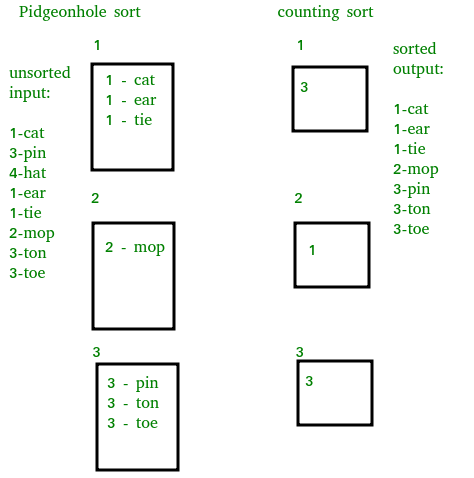Pigeonhole排序是一种排序算法,适用于排序元素数量和可能的键值数量大致相同的元素列表。
它需要O( n + Range )时间,其中n是输入数组中元素的数量,而’Range’是数组中可能值的数量。
算法工作:
- 在数组中找到最小值和最大值。令最小值和最大值分别为“ min”和“ max”。还可以找到“ max-min + 1”的范围。
- 设置一系列初始为空的“鸽子洞”,其大小与范围相同。
- 访问数组的每个元素,然后将每个元素放入其鸽子洞中。将元素arr [i]放在索引为arr [i]-min的孔中。
- 按顺序在鸽孔阵列上开始循环,然后将非空孔中的元素放回原始阵列中。
与计数排序的比较:
它类似于计数排序,但不同之处在于它“两次移动项目:一次到存储桶数组,再一次到最终目的地”。

C++
/* C program to implement Pigeonhole Sort */
#include
using namespace std;
/* Sorts the array using pigeonhole algorithm */
void pigeonholeSort(int arr[], int n)
{
// Find minimum and maximum values in arr[]
int min = arr[0], max = arr[0];
for (int i = 1; i < n; i++)
{
if (arr[i] < min)
min = arr[i];
if (arr[i] > max)
max = arr[i];
}
int range = max - min + 1; // Find range
// Create an array of vectors. Size of array
// range. Each vector represents a hole that
// is going to contain matching elements.
vector holes[range];
// Traverse through input array and put every
// element in its respective hole
for (int i = 0; i < n; i++)
holes[arr[i]-min].push_back(arr[i]);
// Traverse through all holes one by one. For
// every hole, take its elements and put in
// array.
int index = 0; // index in sorted array
for (int i = 0; i < range; i++)
{
vector::iterator it;
for (it = holes[i].begin(); it != holes[i].end(); ++it)
arr[index++] = *it;
}
}
// Driver program to test the above function
int main()
{
int arr[] = {8, 3, 2, 7, 4, 6, 8};
int n = sizeof(arr)/sizeof(arr[0]);
pigeonholeSort(arr, n);
printf("Sorted order is : ");
for (int i = 0; i < n; i++)
printf("%d ", arr[i]);
return 0;
} Java
/* Java program to implement Pigeonhole Sort */
import java.lang.*;
import java.util.*;
public class GFG
{
public static void pigeonhole_sort(int arr[],
int n)
{
int min = arr[0];
int max = arr[0];
int range, i, j, index;
for(int a=0; a max)
max = arr[a];
if(arr[a] < min)
min = arr[a];
}
range = max - min + 1;
int[] phole = new int[range];
Arrays.fill(phole, 0);
for(i = 0; i0)
arr[index++]=j+min;
}
public static void main(String[] args)
{
GFG sort = new GFG();
int[] arr = {8, 3, 2, 7, 4, 6, 8};
System.out.print("Sorted order is : ");
sort.pigeonhole_sort(arr,arr.length);
for(int i=0 ; i Python3
# Python program to implement Pigeonhole Sort */
# source code : "https://en.wikibooks.org/wiki/
# Algorithm_Implementation/Sorting/Pigeonhole_sort"
def pigeonhole_sort(a):
# size of range of values in the list
# (ie, number of pigeonholes we need)
my_min = min(a)
my_max = max(a)
size = my_max - my_min + 1
# our list of pigeonholes
holes = [0] * size
# Populate the pigeonholes.
for x in a:
assert type(x) is int, "integers only please"
holes[x - my_min] += 1
# Put the elements back into the array in order.
i = 0
for count in range(size):
while holes[count] > 0:
holes[count] -= 1
a[i] = count + my_min
i += 1
a = [8, 3, 2, 7, 4, 6, 8]
print("Sorted order is : ", end = ' ')
pigeonhole_sort(a)
for i in range(0, len(a)):
print(a[i], end = ' ')C#
// C# program to implement
// Pigeonhole Sort
using System;
class GFG
{
public static void pigeonhole_sort(int []arr,
int n)
{
int min = arr[0];
int max = arr[0];
int range, i, j, index;
for(int a = 0; a < n; a++)
{
if(arr[a] > max)
max = arr[a];
if(arr[a] < min)
min = arr[a];
}
range = max - min + 1;
int[] phole = new int[range];
for(i = 0; i < n; i++)
phole[i] = 0;
for(i = 0; i < n; i++)
phole[arr[i] - min]++;
index = 0;
for(j = 0; j < range; j++)
while(phole[j] --> 0)
arr[index++] = j + min;
}
// Driver Code
static void Main()
{
int[] arr = {8, 3, 2, 7,
4, 6, 8};
Console.Write("Sorted order is : ");
pigeonhole_sort(arr,arr.Length);
for(int i = 0 ; i < arr.Length ; i++)
Console.Write(arr[i] + " ");
}
}
// This code is contributed
// by Sam007Javascript
输出:
Sorted order is : 2 3 4 6 7 8 8 由于很少满足要求,鸽孔分类的用途受到限制。对于范围远大于n的数组,存储桶排序是一种在空间和时间上更有效的概括。
GeeksforGeeks / GeeksQuiz上的其他排序算法
选择排序,气泡排序,插入排序,合并排序,堆排序,快速排序,基数排序,计数排序,桶排序,ShellSort,梳状排序,